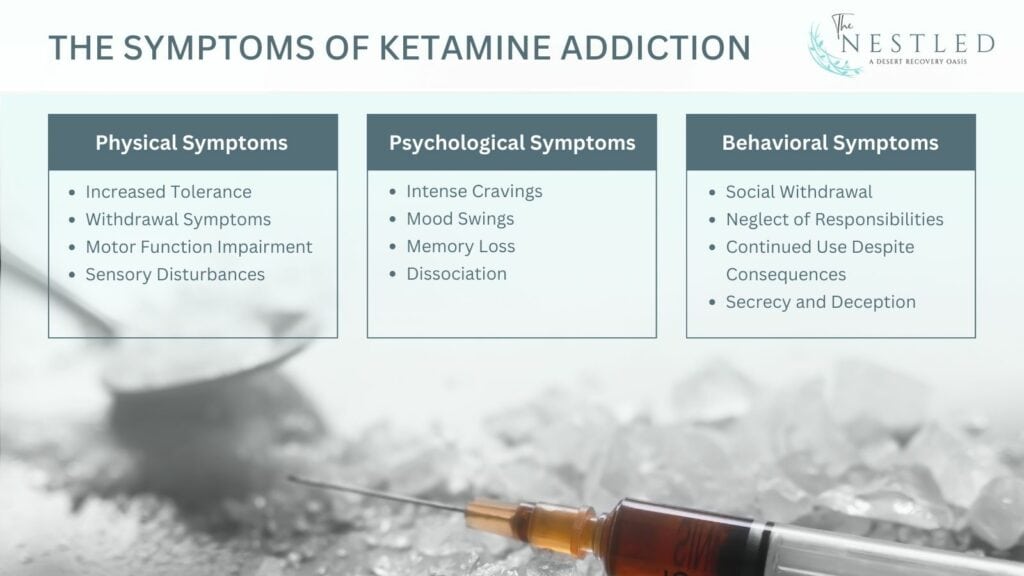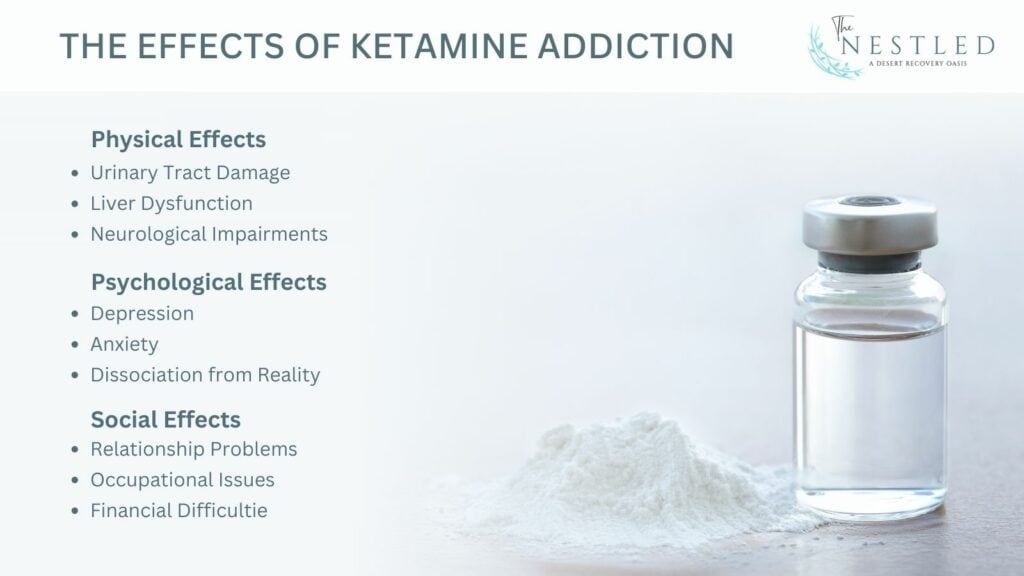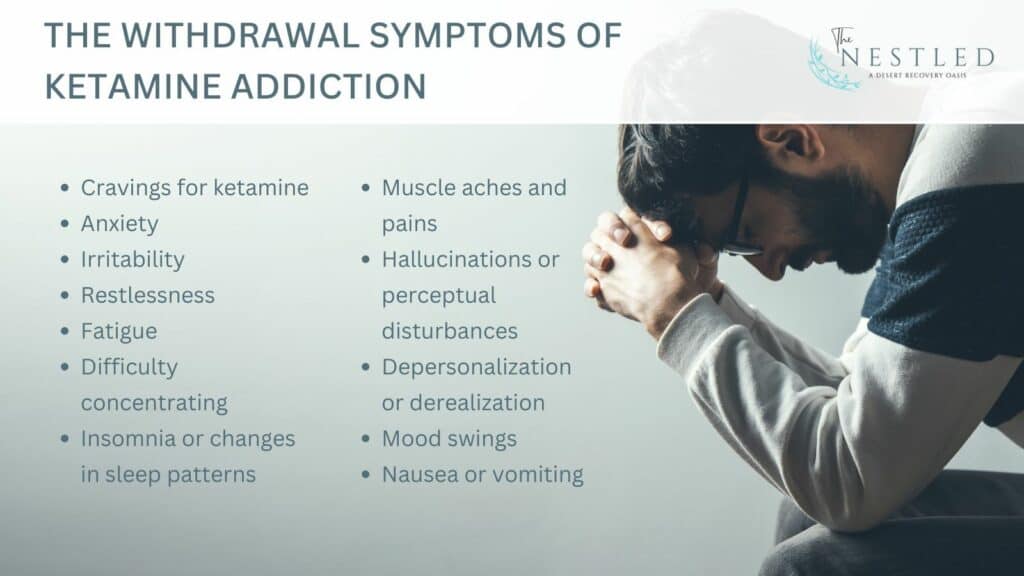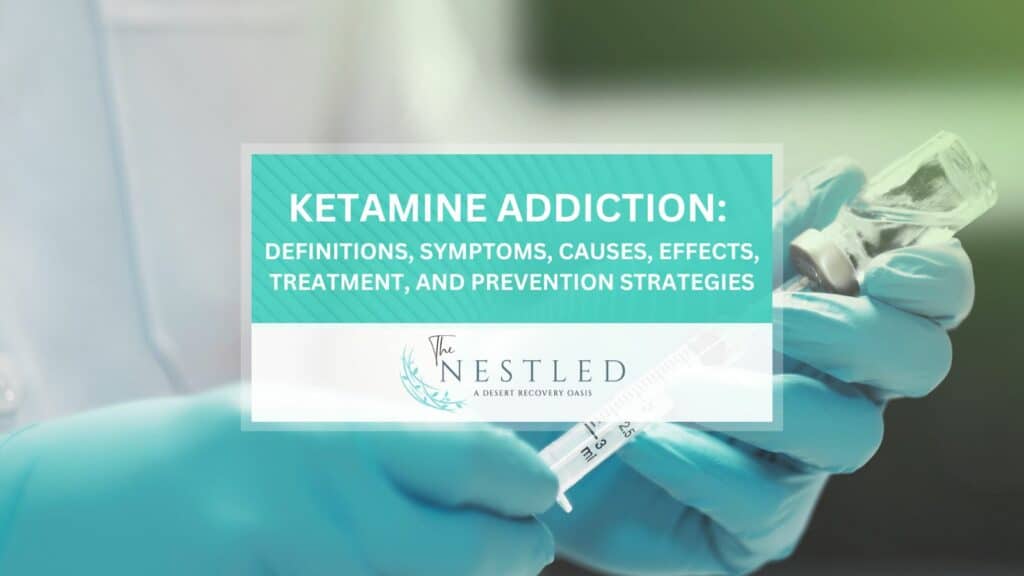Ketamine addiction is a compulsive need to use the drug ketamine despite adverse health and social consequences. Ketamine has a reputation for abuse due to its hallucinogenic and dissociative properties. The U.S. Drug Enforcement Administration (DEA) categorizes ketamine as a dissociative anesthetic because it makes patients feel detached from their pain and environment, which is why it’s abused.
Symptoms of ketamine addiction include a strong desire to use the drug, increased tolerance and withdrawal symptoms when not using, behavioral changes, impaired motor functions, confusion, and amnesia.
The causes of ketamine addiction can be linked to both genetic, psychological, and environmental factors.
The effects of ketamine addiction include urinary tract problems, liver damage, persistent memory issues, strained relationships, isolation, financial difficulties, and reduced performance at work or school.
Treatment for ketamine addiction involves a combination of medical treatments and psychological interventions.
Preventing ketamine addiction starts with education about its risks and effects. Limiting access to the drug, engaging in healthy social activities, and having a solid support network.
What Is Ketamine Addiction?
Ketamine addiction is a condition where an individual develops a compulsive urge to use ketamine despite its harmful effects. Ketamine is a medication used for anesthesia but also known for its hallucinogenic effects. Data from the National Survey on Drug Use and Health’s 2015-2019 study show that an estimated 0.13% of adults used ketamine in the past year, with males more likely to use it.
Ketamine addiction manifests as a relentless craving for the drug, continued use despite awareness of its harmful consequences, and a dependency that dominates the addict’s life. Ketamine addiction involves both psychological engagement and physical dependency.
This dependency leads to a cycle of use that is challenging to break without appropriate intervention and support.
What Are The Symptoms Of Ketamine Addiction?

According to the Diagnostic and Statistical Manual of Mental Disorders (DSM-5, 5th edition), signs that a person is addicted to ketamine can include tolerance, strong craving for ketamine, and abandonment of employment activities because of ketamine.
Ketamine addiction symptoms are categorized into 3: physical, psychological, and behavioral symptoms, but these symptoms vary within individuals.
Physical Symptoms of Ketamine Addiction
- Increased Tolerance: people with ketamine addiction issues find themselves needing larger amounts of ketamine to achieve the same effects. This need indicates the body’s adaptation to the drug.
- Withdrawal Symptoms: individuals who have a ketamine use disorder experience unpleasant physical effects like sweating, nausea, and tremors when not using ketamine.
- Motor Function Impairment: ketamine addiction is shown by difficulty with coordination and balance, resulting in unsteady movements and accidents.
- Sensory Disturbances: people with ketamine addiction experience blurred vision and slurred speech, which can interfere with daily activities.
Psychological Symptoms of Ketamine Addiction
- Intense Cravings: ketamine addiction comes with a compelling urge to use ketamine. It often consumes a person’s thoughts.
- Mood Swings: rapid changes in mood, from euphoria when using to depression when abstaining.
- Memory Loss: Struggling with memory problems, particularly with forming new memories or recalling recent events.
- Dissociation: Feeling detached from reality or oneself is a signature sign of ketamine addiction. Elizabeth Ballard and Carlos Zarate’s 2020 research on ‘The role of dissociation in ketamine’s antidepressant effects,’ asserts that ketamine is strongly linked to dissociation, which is broadly defined as an altered state of consciousness and awareness of the self, environment, and reality.
Behavioral Symptoms of Ketamine addiction
- Social Withdrawal: Isolating from family and friends to spend more time using or recovering from the effects of ketamine.
- Neglect of Responsibilities: Ignoring or failing to meet personal, professional, or academic obligations due to drug use.
- Continued Use Despite Consequences: Persisting in using ketamine even when it causes physical health issues, mental health problems, or social and legal consequences.
- Secrecy and Deception: an individual with ketamine addiction will go to great lengths to hide drug use, including lying about whereabouts and activities.
These symptoms will help you identify when someone is struggling with ketamine addiction, and then you can get them the professional help they need.
What Are The Causes Of Ketamine Addiction?
According to the U.S Drugs Enforcement Administration, ketamine is abused because of its dissociative sensations and hallucinogenic effects. People may choose to take this drug for various reasons, including genetic predisposition, psychological factors, environmental influences, curiosity, and chronic stress. According to the Journal of Psychopharmacology, roughly 11% of the world population used ketamine in 2018.
- Genetic Factors: Certain genetic traits increase the chances of an individual being more prone to addiction. People with a family history of substance abuse are often at a higher risk of developing addictions themselves.
- Psychological Factors: Many individuals turn to ketamine for its ability to produce euphoric and dissociative effects. They use it as a coping mechanism for stress, trauma, or mental health disorders like depression and anxiety. It is easy to misuse the drug when used this way.
- Environmental Factors: Accessibility to ketamine, peer pressure, and social circles that encourage drug use significantly increase the risk of addiction. Joseph Palamar, PhD, and colleagues at NYU Grossman School of Medicine analyzed recreational ketamine use from 2006 to 2019 using the National Survey on Drug Use and Health. Their findings indicate an increase in recreational use and availability, peaking at 0.9 percent in late 2019.
- Curiosity and Experimentation: Particularly among young people, the desire to explore and experiment often leads to trying substances. There is a high chance that one of these substances is ketamine. This experimentation increases the chances of a pattern of use that becomes an addiction.
- Chronic Stress or Trauma: Individuals facing continuous stress or who have experienced traumatic events tend to turn to substances like ketamine for self-medication. The use of these substances unintentionally sets the stage for addiction.
What Are The Effects Of Ketamine Addiction?

According to a drug fact sheet from the Drug Enforcement Administration, shortly after consuming ketamine, users may notice a rise in heart rate and blood pressure, which typically subsides within the next 10 to 20 minutes. Ketamine can also render users unresponsive to external stimuli.
The effects of Ketamine addiction are categorized into 3: physical, psychological, and social effects. These effects affect all aspects of an addicted individual’s life.
What Are The Physical Effects Of Ketamine Addiction?
The 3 ways ketamine addiction affects its users are;
- Urinary Tract Damage: Frequent use of ketamine causes significant harm to the bladder and kidneys, resulting in pain, difficulty urinating, and potentially severe urinary tract issues. According to Winstock Adam. R et al.’s 2012 study ‘The prevalence and natural history of urinary symptoms among recreational ketamine users,’ over 25% of individuals who use ketamine recreationally experience urinary symptoms. These symptoms are directly correlated with both the dose and frequency of ketamine use.
- Liver Dysfunction: Prolonged ketamine abuse puts stress on the liver, leading to potential liver damage.
- Neurological Impairments: individuals addicted to ketamine experience problems with memory, cognitive functions, and even persistent hallucinations.
What are the Psychological Effects of Ketamine Addiction?
The three ways ketamine psychologically affects its users are;
- Depression: Chronic use of ketamine often triggers depressive symptoms. These symptoms include prolonged sadness and a loss of interest in enjoyable activities.
- Anxiety: ketamine addiction causes increased levels of anxiety, which often interfere with daily functioning.
- Dissociation from Reality: Regular intake of ketamine leads to a disconnection from reality. There is a great chance that this disconnection will become persistent and interfere with one’s ability to lead a functional life.
What are the Social Effects of Ketamine Addiction?
The 3 ways ketamine addiction affects its users are;
- Relationship Problems: ketamine addiction strains personal relationships. It causes social isolation and conflicts with family and friends.
- Occupational Issues: ketamine addiction causes an inability to perform at work or school. It often leads to job loss or academic failure.
- Financial Difficulties: The cost of sustaining the ketamine drug habit, coupled with reduced earning capacity, frequently leads to financial instability.
What Are The Treatment Strategies Of Ketamine Addiction?
According to the article reviewed by John C. Umhau, MD, and written by Elizabeth Plumptre for verywell mind on ” What Is Ketamine Addiction?” treatment for ketamine addiction commonly includes various forms of psychotherapy such as cognitive-behavioral therapy (CBT), motivational enhancement therapy, family therapy, or group therapy.
These treatments address both the dependency and the psychological factors associated with the addiction.
1. Detoxification
The main step in treating ketamine addiction is detoxification. Detoxification is a medically supervised process to eliminate ketamine from the body safely. This process helps the addicted individual manage withdrawal symptoms effectively.
2. Rehabilitation Programs
After detoxification, the next step is to enter a rehabilitation program. These programs are often both inpatient and outpatient settings. They provide a structured environment where individuals struggling with substance abuse receive therapy and support designed to help them overcome their addiction.
3. Therapy
Various forms of therapy are necessary for the ketamine addiction treatment process. These therapies include Cognitive-behavioral therapy (CBT), which helps ketamine-addicted individuals identify and change behaviors and thought patterns that lead to drug abuse. Family therapy and support groups also give social support. They help people with substance abuse disorder to understand the impact of addiction on relationships.
4. Medication
Although there are no specific medications approved to treat ketamine addiction directly, there are some medications that help treat symptoms of withdrawal and co-occurring disorders. These treatable symptoms include depression or anxiety.
5. Aftercare and Relapse Prevention
Lastly, long-term aftercare plans and relapse prevention strategies are crucial. These aftercare plans include ongoing therapy, support groups, and lifestyle changes. They help people with ketamine addiction maintain sobriety and manage triggers that lead to relapse.
Ketamine treatment plans are tailored to the individual’s needs to maximize the chances of recovery and maintain long-term sobriety. Acknowledging an addiction is the first step to recovery.
What Are The Withdrawal Symptoms Of Ketamine Addiction?

According to the American Addiction Centers, once ketamine use ceases, the individual may experience withdrawal symptoms including anxiety, depression, and cravings. The withdrawal symptoms of ketamine addiction include:
- Cravings for ketamine
- Anxiety
- Irritability
- Restlessness
- Fatigue
- Difficulty concentrating
- Insomnia or changes in sleep patterns
- Sweating
- Tremors
- Nausea or vomiting
- Changes in appetite
- Muscle aches and pains
- Hallucinations or perceptual disturbances
- Depersonalization or derealization
- Mood swings
What Are the Types Of Ketamine?
The 2 types of Ketamine are injectable solution and powder or crystalline form.
- Injectable Solution: Ketamine is commonly used as an injectable solution for medical procedures, anesthesia induction, and sedation in both human and veterinary medicine.
- Powder or Crystalline Form: Ketamine powder or crystalline form is typically used illicitly for recreational purposes. It can be snorted, swallowed, or dissolved in a liquid for injection. Illicitly manufactured ketamine may also be found in pill or capsule form.
What Are Ketamine Addiction Prevention Strategies
Five prevention strategies for ketamine addiction are education, regulation, support for mental health, community engagement, and family involvement.
1. Education
Creating educational programs in schools and community centers will raise awareness about the risks and consequences of ketamine use. It will provide accurate information to help individuals make informed decisions about ketamine drug use, thereby reducing the chances of addiction.
2. Regulation
Imposing strict regulation on ketamine prescriptions and tighter controls on its distribution will minimize illegal access and misuse. Monitoring systems for prescription drugs will also prevent unauthorized sales and usage and reduce ketamine addiction.
3. Support For Mental Health
The risk of ketamine addiction will be reduced with accessible mental health services for individuals dealing with stress, PTSD, depression, or other mental health issues. It will discourage the need for substance use. Early intervention in mental health prevents the development of addiction.
4. Community Engagement
Encouraging participation in community activities and building strong support networks provides positive alternatives to drug use. Engaged communities foster environments where substance abuse and addiction are less likely to thrive.
5. Family Involvement
Involving families in addiction prevention efforts ensures that individuals, especially teens, have support at home. Education for parents about the signs of ketamine drug use and how to communicate effectively with their children is also crucial.
What Are The Legal Uses Of Ketamine?
Ketamine is legally used as an anesthetic in both human and veterinary medicine due to its ability to induce loss of consciousness and pain relief.
How Does Ketamine Affect The Brain?
Ketamine acts on the brain’s neurotransmitters, particularly glutamate, leading to altered mood, perception, and thought processes. It creates feelings of detachment from self and environment. A drug fact sheet provided by the DEA states that ketamine distorts perceptions of sight and sound and makes the user feel disconnected and not in control.
Can Ketamine Cause Permanent Damage?
Yes, prolonged use of ketamine causes permanent damage to the bladder. This damage is known as ketamine cystitis. It also causes long-term cognitive impairments, including memory loss and difficulty concentrating.
Where To Find Treatment For Ketamine Addiction?
Treatment for ketamine addiction is available at rehabilitation centers, addiction treatment facilities, or through medical professionals specializing in addiction recovery.
What Are The Different Forms Of Ketamine?
Ketamine is commonly found as a white powder or a liquid, which can be injected, consumed orally, or snorted.
How does the societal perception of ketamine use differ from that of opioid use, and how does this impact treatment and prevention strategies?
The societal perception of ketamine use differs from that of opioid use, which can impact treatment and prevention strategies. Ketamine is often seen as a “club drug” associated with recreational use in nightlife settings, leading to a perception that its use is less dangerous or more socially acceptable. On the other hand, opioid use is widely recognized as a severe public health crisis with a high potential for addiction and overdose. These differing perceptions can influence how individuals seek help and the types of prevention campaigns that are effective. Tailoring prevention and treatment strategies to address these perceptions can improve their effectiveness by resonating more with the target audiences and reducing stigma associated with seeking help.
What Are The Different Slang Names For ketamine?
Slang names for ketamine include “K,” “Special K,” and “Kit Kat.”
Where And How Is Ketamine Typically Manufactured And Produced?
Ketamine is typically manufactured in clandestine laboratories and can be produced in various forms, including powder or liquid.
How does the mechanism of action of ketamine influence its potential for addiction compared to Ambien?
Ketamine and Ambien have different mechanisms of action that influence their potential for addiction. Ketamine acts primarily as an NMDA receptor antagonist, leading to its dissociative and hallucinogenic effects, which can be highly addictive due to the escape from reality it offers users. In contrast, Ambien (zolpidem) works by enhancing the activity of GABA, a neurotransmitter that induces sedation and sleep. The addictive potential of Ambien is more related to its ability to create a dependence on its sedative effects for sleep.
What Are The Law Enforcement Efforts And Legal Implications Of Ketamine?
Law enforcement efforts focus on controlling the sale and distribution of ketamine, as its misuse can lead to serious health consequences.
What Is The Role of Law Enforcement Agencies In Stopping Ketamine Distribution and Use?
Law enforcement agencies play a crucial role in enforcing laws related to the sale and distribution of ketamine to prevent its misuse.
What Are The Drug Control Policies And Implications For Ketamine?
Policies regarding ketamine control aim to regulate its production, distribution, and use to minimize its misuse and potential harms.
What Are The Legal Consequences For Using And Selling Ketamine?
The legal consequences for using and selling ketamine include fines, imprisonment, and legal records.
How Are The Effects Of Ketamine Addiction Similar To Or Different From Other Drug Addictions?
Ketamine addiction has similar effects to other drug addictions, such as dependence and withdrawal symptoms, but the specific effects vary depending on the substance.

Share This Post




